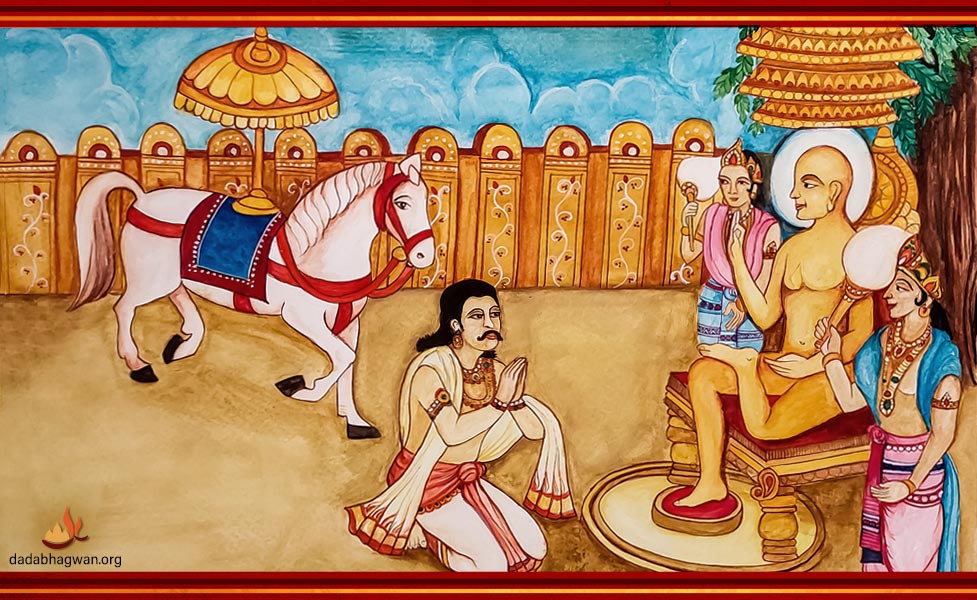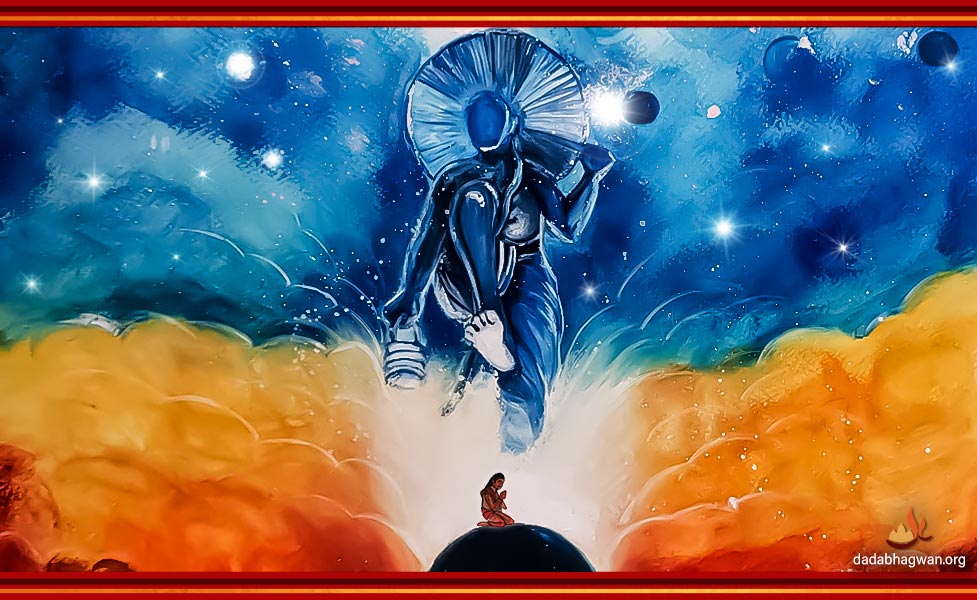Shree Munisuvrat Bhagwan: Life Stories of the Twentieth Tirthankara
Shree Munisuvrat Swami was the twentieth Tirthankara of the present time cycle. His body complexion was black and His height measured 20 bows.
Munisuvrat Swami’s symbol is tortoise. Varun Yaksha Dev and Nardatta Yakshini Devi are His Shaasan Dev and Shaashan Devi, respectively.
Come, let’s read about Munisuvrat Swami’s two births before being a Tirthankara and His life story as a Tirthankara.
Shree Munisuvrat Bhagwan – Past Births
In the antepenultimate birth, Shree Munisuvrat Swami was King Shurshreshth. He took Diksha, and with his devotional worship, he attained a celestial life form (dev gati).
Shree Munisuvrat Bhagwan – Birth and Diksha
After completing the lifespan as a celestial being, the Soul of King Shurshreshth took birth as a Tirthankara in the Rajgruhi Nagri at King Sumitra and Queen Padmavati’s place. After marriage, Prince Munisuvrat remained as the crown prince (yuvraj) for some time. Thereafter, He took Diksha. After 11 months of Diksha, He attained Keval Gnan.
Deshna

After Lord Munisuvrat Swami attained Keval Gnan, His Samovasaran was created. Munisuvrat Swami gave Deshna describing the true form of this world and how Moksha is attained.
To attain Moksha, the most important thing is that the goal of Moksha should be decided. Until one does not feel this world is a bondage, how can the desire for Moksha arise? One just speaks in words, “It’s worth going to Moksha; there is nothing in this world!”, but internally, it is, “The worldly life means everything!”; not Moksha, but the worldly life is what one finds beautiful.
“Whether I deserve Moksha or not, but my goal is to go to Moksha only. I am a Soul and the Soul's inherent nature is its liberated form; then, how can I not achieve Moksha?” Why should I get into the negativity of, “No, no! Moksha is very difficult; to attain it is quite tough; it cannot be attained. I will have to bear a lot of hardships; I will have to renounce a lot of things.” This thinking is wrong. Where there is Moksha, there is no hardship. It is due to hardship that this world exists. For one who is going to Moksha, there is neither any effort nor any hardship. One who is going to Moksha is completely liberated, is in bliss.
Many people close the doors (of their mind) saying (believing), “In the present age (of Kaliyug), there is no Moksha.” Moksha is always there. In the smallest part of a second (one samay), a maximum of 108 and a minimum of 1 Soul can go to Moksha. When so many Souls can go to Moksha, then why can’t we?
What Does Moksha Mean?
- In the first stage, in this very life, the realization that the Self is distinct from the body (Atma Darshan) happens; freedom from all kinds of sufferings is attained and we get to experience the eternal bliss of the Soul; in this very life, right Vision of 'I am pure Soul’(Samyak Darshan) should occur.
- When all karmas finish, when not a single parmanu (the smallest, most indivisible and indestructible particle of inanimate matter) is stuck to the Soul, when Soul is absolutely without any covering, one goes to Moksha. Then, the cycle of birth and death does not remain.
Every Soul that has gone to Moksha resides in the Siddha Kshetra. Where the Universe, which is called Lok, ends, above it is Alok, where there’s only the element of space. Between that Lok and Alok is the Siddha Kshetra.
When Keval Gnan happens, on this Earth, in this body itself, the bliss of being in the Siddha Kshetra is experienced. The only difference being that the body’s naam, gotra, ayushya and vedniya—these four aghaati karmas are remaining, which have to be finished.
When body also is not there, meaning aghaati karmas also are not there, that’s when they go to Siddha Kshetra. In Siddha Kshetra, for infinite period, one experiences infinite happiness of the Soul; that bliss, even Gnanis are incapable of describing it. That bliss where even speech doesn’t reach is worth experiencing only. To understand the infinite bliss of the Soul, it is said as a simile that from the infinite rays of Siddha Kshetra, if only one ray of happiness comes on Earth, then that happiness would touch each one so much so that for one whole year, no one would feel unhappiness at all; only happiness would remain. Then, what must be the state of the Siddha Atma who is experiencing these infinite rays—that’s beyond our imagination! The reason why people are pursuing Moksha is that, here, liberation from all kinds of unhappiness happens, but the experience of infinite happiness, the experience of Self’s own permanent eternal happiness is forever in Moksha only.
Moksha happens when knowledge and action, both are together, not the action done through ignorance, but action with the activity of the Self to See and Know. So once the knowledge of, ‘I am the Soul’ has arisen, thereafter, every action is that of the body. The one doing action is separate and the Soul is the Knower; it is separate. Internally, there is a complete demarcation between the doer and the Knower; any action that happens, when is accompanied with Knowledge, that’s when Moksha happens.
For Moksha, first and foremost, ‘who am I?’—that knowledge should arise. To make one realize this, one needs to meet a Gnani, who gives us this knowledge. Gnanis are the leaders on the path of Moksha.
Who Can Be Called a Gnani?
“Mokshamargasya Netaram Bhettaram Karmabhubhritaam;
Gnataram Vishwatattvanaam Vande Tadgunlabdhaye”
meaning
No matter what kind of karma it is, Gnanis burn them all and they know all the eternal elements in the Universe; bowing to Gnani, we immediately attain all His virtues.
If we happen to meet such a Gnani, then Moksha is effortless. Moksha is not far away; finding Gnani is difficult. If we find him, then Moksha is within our reach. Such Gnanis are there for sure; we just need to find one.
We remain so engrossed in the world; we have so much of interest in attachments that we do not feel like moving away from them. We do not feel at all that attachment is a bondage. There is no peace in this vicious Kaliyug, yet due to attachment, we do not feel like this is a bondage.
Moksha means freedom from all kinds of sufferings. We have problems related to body, problems related to mind, problems related to speech—there are so many problems; no peace of mind anywhere. Therefore, determine that I want to go to Moksha only; whatever worldly obligations are there, I want to finish them. If it’s my goal, then everything will get over. The Vitaraags and the Tirthankaras have said that it is worth going to Moksha only. They themselves have gone to Moksha and have opened up the path of Moksha.
Moksha is easy, but what obstructs is our own insistence, adamance and arrogance. The door to Moksha is narrow. We can go through it if we get straight; if we act crooked, then we cannot reach there ever. Where there is even slight insistence, it is nothing but poison there. Insistence itself is war. God’s path is without any insistence.
Many people have an intoxication of their actions, their penance, knowledge and status. Where there’s intoxication, there is no Moksha. Moksha happens of the one who is not intoxicated. Those who became high-headed (of their superiority), none of them have gone to Moksha; all kept wandering.
The subtlest of subtle in this world, if there is, it is the Soul. If one becomes the Soul, then one becomes the subtlest, the smallest. All are trying to become superior to others. One who (whose ego) gets high-headed, gets trapped, falls and gets beaten. While following the Vitaraag religion, if even slight contamination gets inside, then that person falls down. A lot of awareness is required for Moksha.
The path of Moksha is a very high thing. One who has got tremendous ability can walk on this path. It’s not a coward’s job; this is the job of the valorous. Of not to fight with people but the valour to win over the internal enemies is what is required. The Tirthankaras have shown this bravery, and thus, have become a role model for us.
Munisuvrat Swami's beautiful Deshna inspired a lot of people. Many people took Diksha and progressed on the path of Moksha.
Once, while Munisuvrat Bhagwan was giving Deshna, someone asked Him, “Prabhu! Many kings, Acharyas and Sadhus are seated in your Deshna. Who amongst these perceived this Deshna perfectly well?”
Lord replied, “None of these. In that corner, there is the king’s horse. He has understood my Deshna perfectly well.” The horse, in his previous life, was a Shravak, who with a lot of devotional worship, had constructed a Jinalay (a temple of a Tirthankara). Consequently, he bound very good merit karma. However, on the flip side, he was so greedy that all day long, he would keep thinking of money only. Due to this, he got this birth of a horse (from a human, he came into the animal life form), and because of his merit karma, he got this religion.
Story of the Ninth Chakravati, Mahapadma
During the time of Shree Munisuvrat Swami, the ninth Chakravati, Mahapadma, was living in Hastinapur. His father was King Padmottar and his elder brother was Vishnu Kumar. Mahapadma and Vishnukumar were appointed as yuvrajas. The king had one minister named Namuchi.
Namuchi, in his earlier job, had a lot of hatred towards Jain Sadhus and Acharyas. Hence, he had driven out all Jain Sadhu Munis from the kingdom, following which he was sacked by the king there. Namuchi came to King Padmottar’s kingdom, but he had a lot of bad feelings inside him.
Once, Minister Namuchi helped Yuvraj Mahapadma win a war. Mahapadma was so pleased with him such that he offered him a boon. The minister reserved his right to ask for a wish later. The yuvraj agreed to it. Later, Yuvraj Mahapadma won over the entire world and became a Chakravarti. Thereafter, his father and elder brother renounced the world and took Diksha.
Once it so happened that those Sadhus, whom Namuchi had driven out earlier, arrived into the kingdom of Chakravarti Mahapadma. This reminded Namuchi of the consequences he was forced to bear due to these Sadhus. Hence, he felt like taking revenge. To take revenge, Namuchi requested Chakravarti Mahapadma to give him the rule of the entire Chakravarti kingdom for a week’s time. Chakravarti Mahapadma honoured his commitment and handed over the throne to Namuchi.
However, when Namuchi tried to drive away all the Sadhus from the kingdom, the group of Sadhus asked for help from King Padmottar and Vishnu Kumar who had become Sadhus now. Vishnu Kumar tried to persuade Namuchi to not do so, but the latter refused. Vishnu Kumar then asked Namuchi to give land measuring only three steps for the Sadhus to stay. Namuchi agreed to the three steps and nothing more than that.

Now Vishnu Kumar, using his extraordinary powers, expanded his form to cover the entire world in just two steps. That’s when the Chakravarti King begged for pardon.
Shree Munisuvrat Bhagwan - Nirvana
Shree Munisuvrat Swami attained Nirvana from the Samet Shikharji Mountain and went to Moksha.
subscribe your email for our latest news and events





